Frost-resistant early ripening variety of honeysuckle "Lakomka"
The honeysuckle variety Gourmet stands out favorably against the background of others and can rightfully be called an elite culture due to a number of positive characteristics and an almost complete absence of disadvantages.
We bring to your attention a detailed description of the variety, its pros and cons, planting and care requirements.
The content of the article
Description of the variety of honeysuckle Lakomka
Lakomka is a variety of edible honeysuckle, bred in Russia... 100 g of its fruits contain 9.8% sugar, 30% ascorbic acid, 6 mg B vitamins, 70 mg potassium, 19 mg calcium, 35 mg sodium, 21 mg magnesium, 35 mg phosphorus, 0.8 mg iron.
Berries are useful for hypertension, metabolic disorders, malfunctions of the digestive system and help boost immunity.
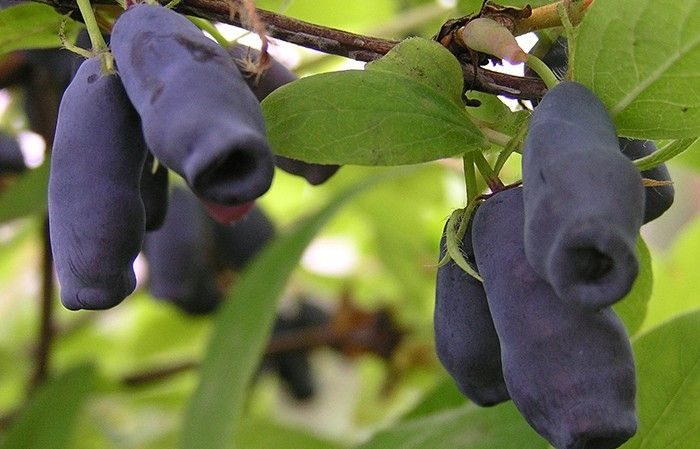
Origin and development, history of breeding
Honeysuckle Gourmet was bred by the breeder of the Nizhny Novgorod State Agricultural Academy V.A.Fefelov as a result of crossing of the Ural forms of Turchinov's honeysuckle with sweet-fruited species.
The variety has been under state variety testing since 1991, included in the state register of Russia in 1998.
Characteristics, description of appearance, taste
The bushes are medium-sized (height up to 1.5 m), compact, with a dense oval crown and thin, straight shoots of anthocyanin color. The leaf plates are medium in size, almost flat, have an elongated shape and are colored light green.
The berries are elongated-oval with a flat top, reach a length of 2-2.8 cm and weigh 0.8-1.3 g. They are covered with a dense, smooth skin of dark blue color with a bluish waxy coating.
The pulp is fibrous, juicy, characterized by a pleasant sweet-sour taste without bitterness and astringency.
Features of the use of this variety
Berries are consumed fresh, frozen, used to make jams, jams, marmalades, jam, juices, medicinal decoctions and tinctures.
The bushes, due to their decorativeness, are suitable for decorating the site and forming a hedge.
Ripening period, yield and fruiting
This is an early ripening variety of honeysuckle - the ripening of the crop begins in mid-June and lasts until the end of July.
The bushes begin to bear fruit 3-4 years after planting, the maximum fruitful age for Gourmet is 6-20 years. Average yield - 0.8 kg per 1 sq. m.
Disease and pest resistance
The gourmet is resistant to diseases and pests. But under unfavorable conditions, the bushes can infect cercospora, powdery mildew, mosaic, aphids, scale insects, ticks.
Cold and drought resistant
The variety tolerates a drop in air temperature to -50 ° C and is not afraid of recurrent spring frosts. Drought negatively affects the yield and quality of berries.
For which regions it is best suited and what is the exacting climate
The variety is included in the state register for the Volga-Vyatka region, it is successfully grown in the middle lane and north-western regions.Gourmet is recommended for planting in the Moscow region, the Non-Black Earth Zone, Belarus, the Baltic States and in the north of Ukraine.
The main advantages and disadvantages of the variety
In addition to the sweet and sour dessert without bitterness taste and benefits of berries, honeysuckle Gourmet has the following advantages:
- early maturation;
- stable and high yield;
- the possibility of universal use;
- frost resistance;
- persistent immunity to diseases;
- slow growth of root shoots;
- decorative type of bushes.
Cons of the variety:
- shedding of berries;
- uneven maturation;
- the need for pollinators.
What is the difference from other varieties and hybrids
Comparison of Gourmet with other varieties of honeysuckle:
| Variety | Average weight of berries, g | Berry shape | Taste | Productivity, kg / bush |
| Gourmet | 0,8-1,3 | Elongated oval with flat top | Sweet with sourness | Up to 5 |
| Amazon | 1,1 | Jug-shaped | Sweet and sour | 1,3-1,5 |
| Baikal | 1 | Oblong | Sweet | 1,7-1,9 |
| Berel | 0,45 | Conical | Sweet and sour with bitterness | 3-4 |
Agrotechnics
Gourmet is an unpretentious variety, but it will be possible to achieve good plant development and abundant yield only if agrotechnical requirements are met.
Choosing a place in the garden and preparing holes
The landing site for Gourmands should be well lit, protected from wind and drafts.
Reference. On bushes growing in the shade, the berries grow smaller and sour.
This is a moisture-loving culture, but in the case of waterlogged soil, the risk of rotting of the root system increases. Therefore, before planting seedlings, check the groundwater level - it should be at least 1-1.5 m.
Preparing for landing
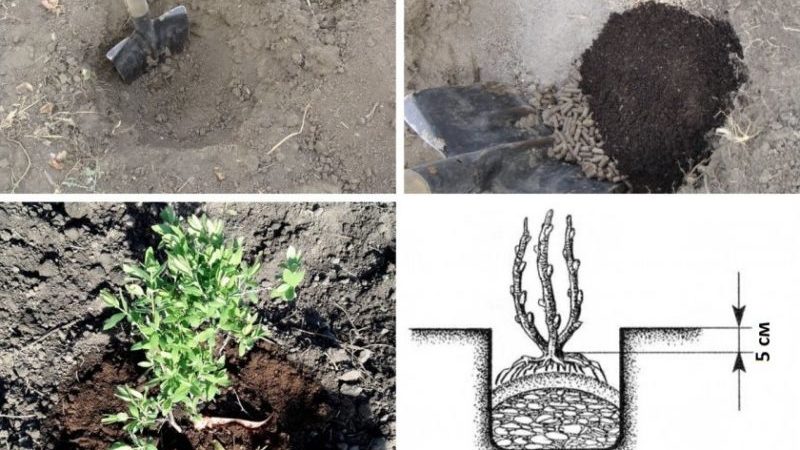
For planting, biennial seedlings with a height of about 30 cm with a developed underground part are chosen, in which the length of the rhizome is about 25 cm, there are several aerial shoots with buds and there are no signs of diseases or pests.
15-20 days before planting, the site is cleared of weeds and plant residues, dug up and fertilized into the soil: 10 kg of manure or humus, 30-60 g of superphosphate, 20-30 potassium salt per 1 sq. m.
Ground requirements
The variety grows well in light, fertile soil with good aeration, moisture permeability and neutral acidity. The most suitable option is loam and sandstone.
Reference. Lime or dolomite flour is added to the over-acidified soil before planting.
Timing, scheme and landing rules
The gourmet is planted in the ground from the beginning of September to the end of October, while there should be at least three weeks before the onset of stable frosts.
Landing rules:
- Dig planting holes 50 × 40 cm in size in the prepared area.
- Pour a layer of drainage from crushed stone or broken brick on the bottom of each, and a nutritious soil mixture on top (2-3 shovels of excavated earth, a bucket of humus, 200 g of wood ash and 30 g of superphosphate).
- Form a small hill in each hole and install a seedling on it, spreading its roots.
- Sprinkle the plant with soil, compact it slightly and water (a bucket of water on the bush).
- When the ground subsides after watering, add more soil so that the root collar is 7 cm above the surface.
- Mulch the root zone with peat.
The distance between the bushes should be 2 m, between the rows - at least 1 m.
Features of growing and nuances of care
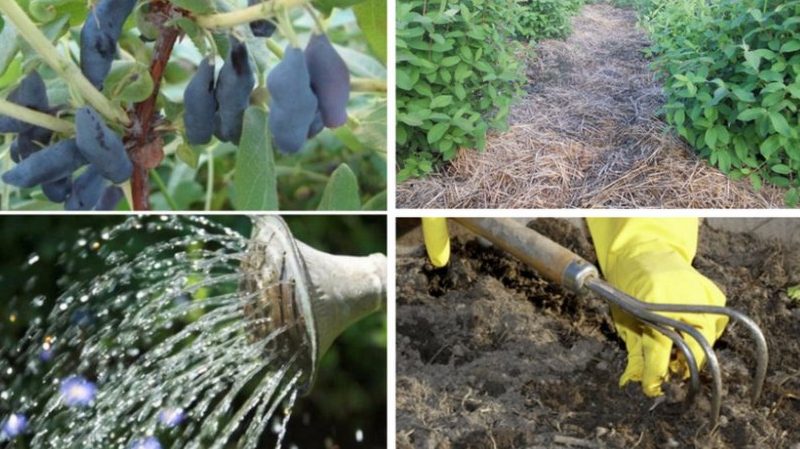
In spring and summer, plants are watered every two days at the rate of a bucket of water for each bush. In hot and dry weather, the water consumption is increased to two buckets per bush. In the fall, watering is stopped.
After each watering or rain, the soil is loosened to improve the access of moisture and air to the roots. At the same time, the site is weeded, removing weeds, which provoke high humidity and the development of diseases.
Provided that the bushes are planted in fertilized soil, they begin to feed the plants in 2-3 years. In early spring, 5-7 kg of humus is applied under each bush, and in the fall - potassium-phosphorus fertilizers (superphosphate, kainite).
For bushes under 10-12 years old, only sanitary pruning is carried out, removing in the spring (end of March) all dry, damaged and frozen shoots. Adult bushes rejuvenate - they completely remove all branches or leave some of the strongest ones.
Also, during the season, the crown of the bush is formed - they thin out thickened areas, remove old shoots that do not bear fruit, shorten the young ones to improve branching.
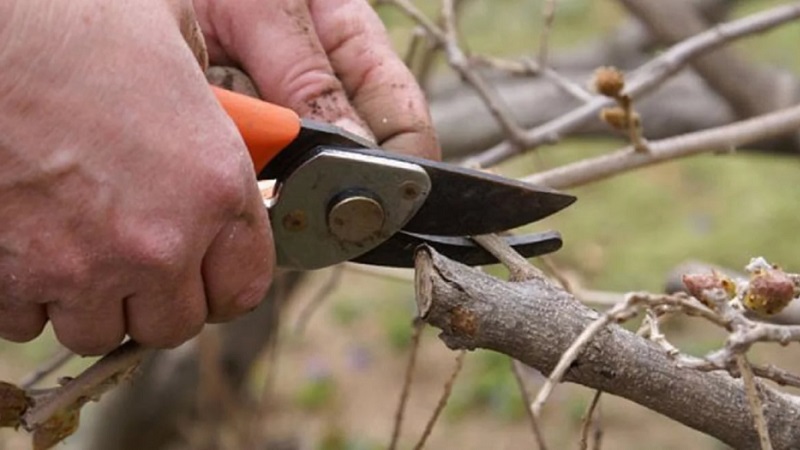
Pollinators
Since the variety is self-fertile, 2-3 other varieties of honeysuckle are planted nearby for cross-pollination.
The best pollinators for Gourmet:
- Nymph;
- Blue spindle;
- Blue bird;
- Malvina;
- Kamchadalka;
- Nizhny Novgorod early;
- Moraine;
- In memory of Kuminov;
- Start.
Disease and pest control

Diseases and pests dangerous for Gourmet:
| Disease, pest | Signs | Treatment / prevention |
| Cercosporosis | White spots with brown edging appear on the leaves. | Plants are treated with fungicidal preparations: "Skor", "Vectra", "Fundazol", "Cumulus", "Topaz". |
| Powdery mildew | White powdery bloom is visible on the leaves. | |
| Mosaic | Leaves become small, develop poorly. | Plants cannot be cured. The infected bushes are dug up and burned. |
| Aphid | The pest feeds on the sap of shoots and leaves, which slows down the growth and development of plants, and decreases productivity | Treatment of bushes with insecticidal or insectoacaricidal preparations, for example, "Aktellik", "Fufanon", "Aktara", "Eleksar" or "Inta-Vir".
For prevention, plants are treated with "Lepidocide" or "Confidor". |
| Shields | Small insects sucking juice from shoots. As a result, the bushes dry up and die. | |
| Mites | Dark spots form on the leaves; at the end of summer, the leaf plates turn brown and dry out. |
Preparing for winter
In autumn, the bushes stop watering so that they stop growing and go into a dormant phase, pruning and burning the cut parts of the plants. The site is cleared of fallen leaves, weeds and other debris and dug up, and the bushes are treated from pests and diseases.
Young plants are covered with protective material and covered with snow, adult bushes do not need winter shelter.
Reproduction
Gourmet is propagated by vegetative methods: cuttings, dividing a bush or layering.
When propagating by layering in early spring or late autumn, a lower one-year shoot is chosen on an adult bush, bent to the ground, fixed, sprinkled with soil and watered regularly. Six months later, an independent root system is formed on it, after which the shoot is separated from the mother plant and planted in a permanent place.
Dividing the bush - the simplest breeding method for honeysuckle. In the fall, they dig up an adult, overgrown bush and divide it into several parts so that each one has developed shoots and root processes. Delenki are planted in the ground and looked after as if they were mature plants.
For grafting at the beginning of March, cuttings 0.4-0.5 cm thick and 7-12 cm long with 2-3 pairs of leaves and at least one internode are cut from lignified shoots. They are planted in a peat-sand mixture, deepening by 1-2 cm, covered with foil and kept at a temperature of + 20 ... + 25 ° C. Rooting occurs after 10 days.
Harvesting
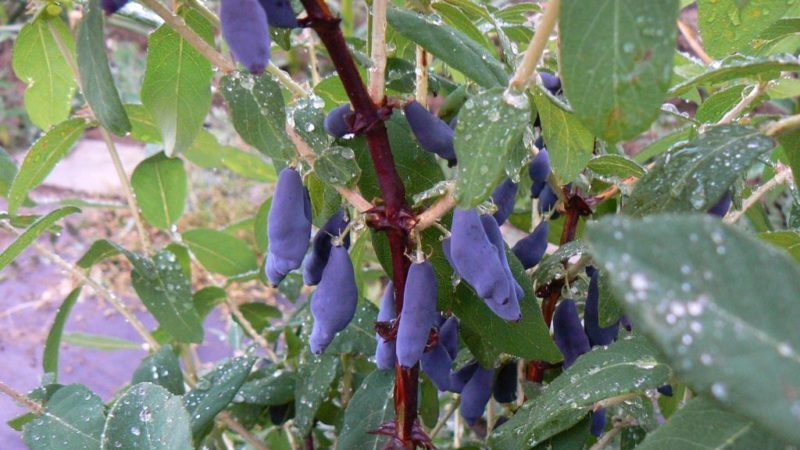
The crop ripens unevenly from mid-June to late July, so harvesting is carried out in several stages. The berries are harvested by hand or with a combine, after placing a synthetic fabric under the bushes, on which they will fall.
The fruits are kept in the refrigerator for three days.
What can be the difficulties in growing
When growing Gourmet, the following problems may arise:
- the yield is low, the berries are small, unsweetened and ripen slowly - the bushes do not have enough sunlight;
- bitterness is felt in the taste of the fruit - the plant did not have enough moisture.
Advice and feedback from experienced gardeners about the variety
Experienced gardeners recommendations:
- for reproduction, use the method of dividing a bush or layering - these are the simplest ways;
- do not neglect preventive treatments for pests and diseases, despite the resistance of the variety.
Gardeners respond positively to the Lakomka variety: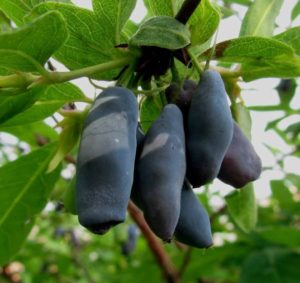
Svetlana, Ryazan: “I planted this honeysuckle six years ago. At first, the bushes developed slowly, I already thought that nothing good would come of them. But last year they have grown noticeably, have increased the crown. It was then that we first tasted the fruits of Gourmet. The name fully justifies itself - the berries are incredibly tasty, sweet with a slight sourness. The grandchildren are delighted. "
Roman, Suzdal: “I bought Gourmet seven years ago. I was just looking for something unusual for the garden, the seller advised this honeysuckle. At first, the bushes were not impressed with either the view or the berries. But two years ago, the situation changed - the bushes grew, the crown became thick. Now I recommend this variety to all my friends - it decorates the garden, and the berries are delicious and useful gives. "
Conclusion
Gourmet - frost-resistant, unpretentious honeysuckle in care, with growing which even novice gardeners can handle. The variety is characterized by an ornamental type of bushes, early ripening of large and tasty fruits, stable fruiting and high productivity.